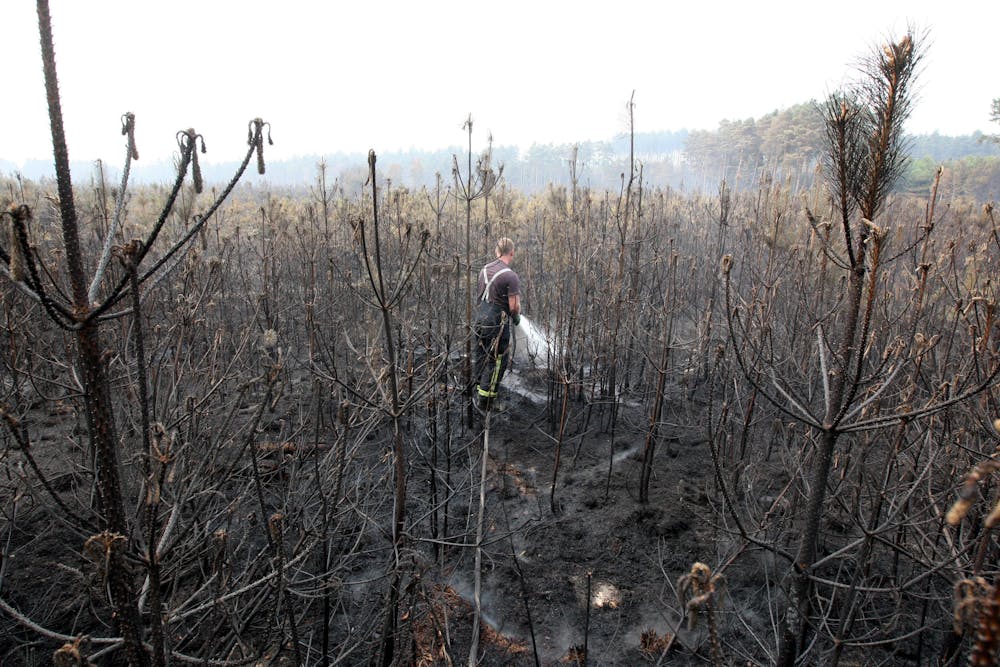The Devastating Effects Of Wildfires On Rare UK Wildlife

Table of Contents
Habitat Loss and Fragmentation
Wildfires cause catastrophic habitat loss, directly impacting the survival of countless species. The immediate destruction of vital habitats eliminates essential food sources and shelter, leaving many animals vulnerable.
Direct Loss of Shelter and Food Sources
- Heathlands: These unique ecosystems, home to species like the Dartford warbler and smooth snake, are particularly susceptible. Recent wildfires have destroyed hundreds of hectares of heathland, leading to significant population declines.
- Peat bogs: These waterlogged areas support specialized plants and animals adapted to acidic conditions. Wildfires can drastically alter the hydrology of peat bogs, destroying irreplaceable habitats and impacting species like the scarce chaser dragonfly.
- Adders: These reptiles rely on specific microhabitats for thermoregulation and shelter. Wildfires destroy these refuges, leaving them exposed to predation and harsh environmental conditions.
- Insects: Many insect species, crucial for pollination and the food chain, are highly sensitive to fire, with their larval stages and nesting sites especially vulnerable. The loss of these insects can have cascading effects throughout the ecosystem.
Fragmentation and Isolation of Populations
Wildfires don't just destroy habitats; they also fragment them, creating barriers that isolate populations of animals and plants. This isolation has severe consequences:
- Inbreeding: Small, isolated populations are more prone to inbreeding, which reduces genetic diversity and weakens their resilience to disease and environmental changes.
- Reduced gene flow: The inability for individuals to move between fragmented habitats prevents the exchange of genetic material, hindering adaptation and evolution.
- Increased vulnerability: Isolated populations are more vulnerable to extinction events, as they lack the genetic diversity and population size to withstand shocks. For example, fragmentation caused by wildfires can severely limit the ability of the slow-worm to disperse and colonize new areas.
Impacts on Specific Endangered Species
The impact of wildfires is particularly devastating for endangered species, which often have small, localized populations and limited adaptability.
Case Study 1: The Sand Lizard
The sand lizard, a UK Biodiversity Action Plan priority species, is highly vulnerable to wildfires. These reptiles require specific open, sandy habitats for basking and laying eggs. Wildfires destroy this habitat, directly leading to:
- Habitat loss: Direct destruction of basking sites and nesting areas.
- Reduced reproductive success: Fires can kill eggs and young lizards, significantly impacting population growth.
- Increased predation risk: The loss of cover increases the vulnerability of sand lizards to predators. Recent studies have shown a correlation between wildfire frequency and significant population declines in sand lizard populations in affected areas.
Case Study 2: The Nightjar
The nightjar, a cryptic nocturnal bird, relies on heathland and moorland for nesting and foraging. Wildfires severely impact their habitat:
- Nest destruction: Fires directly destroy nests and eggs.
- Loss of insect prey: The destruction of vegetation reduces the abundance of insects, the nightjar's primary food source.
- Compromised camouflage: Nightjars depend on camouflage for protection; the loss of vegetation makes them more visible to predators. Recovery is slow, as suitable nesting habitats take years to regenerate after a wildfire.
Long-Term Ecological Consequences
The ecological damage caused by wildfires extends far beyond the immediate destruction of habitats.
Soil Degradation and Erosion
Wildfires drastically alter soil properties, leading to significant long-term consequences:
- Loss of organic matter: Fire consumes vital organic matter, reducing soil fertility and nutrient availability.
- Increased erosion: The loss of vegetation exposes the soil to wind and rain, leading to increased erosion and loss of topsoil.
- Hydrophobicity: Intense heat can make the soil water-repellent, impacting water infiltration and increasing runoff, leading to increased risk of flooding. This hinders plant regeneration and recovery.
Changes in Species Composition
Wildfires can dramatically alter the composition of plant and animal communities:
- Shift in dominance: Certain species, particularly those adapted to fire or that thrive in disturbed environments, may become dominant, altering the ecosystem's overall structure.
- Invasive species: Wildfires can create opportunities for invasive species to establish themselves, further disrupting the natural balance. For example, non-native grasses may quickly colonize burned areas, outcompeting native vegetation.
Increased Risk of Flooding and Landslides
The loss of vegetation after a wildfire drastically increases the risk of flooding and landslides:
- Reduced water absorption: The burned soil's inability to absorb water increases surface runoff, leading to flooding in downstream areas.
- Soil instability: The loss of root systems destabilizes the soil, increasing the risk of landslides, especially on slopes. These secondary hazards further impact wildlife, destroying remaining habitats and causing direct mortality.
Conclusion
Wildfires pose a truly devastating threat to rare UK wildlife, causing significant habitat loss, fragmenting populations, and directly impacting vulnerable species. The long-term ecological consequences, including soil degradation, altered species composition, and increased risk of secondary hazards such as flooding and landslides, underscore the urgent need for comprehensive and proactive conservation strategies. Protecting these invaluable ecosystems requires a multifaceted approach, including wildfire prevention through careful land management, habitat restoration projects, robust conservation management plans for endangered species, and increased public awareness.
Call to Action: Learn more about the devastating effects of wildfires on rare UK wildlife and how you can contribute to conservation efforts. Support organizations working to protect these vital habitats and species, such as the Wildlife Trusts and the RSPB. Get involved in local conservation initiatives to help mitigate the impact of wildfires and safeguard the future of UK biodiversity. Together, we can prevent further loss and ensure the survival of our unique and irreplaceable wildlife.

Featured Posts
-
 Brexit The Ongoing Challenges Of The Gibraltar Dispute
May 13, 2025
Brexit The Ongoing Challenges Of The Gibraltar Dispute
May 13, 2025 -
 Beyond Bmw And Porsche Foreign Automakers Difficulties In China
May 13, 2025
Beyond Bmw And Porsche Foreign Automakers Difficulties In China
May 13, 2025 -
 Mc Kellen On Young Actors And Staying In The Closet
May 13, 2025
Mc Kellen On Young Actors And Staying In The Closet
May 13, 2025 -
 10 Aktori Koito Sa Spasili Khora Geroichni Istorii I Snimki
May 13, 2025
10 Aktori Koito Sa Spasili Khora Geroichni Istorii I Snimki
May 13, 2025 -
 Analisis Laga Venezia Vs Atalanta Performa Jay Idzes Dan Hasil Imbang
May 13, 2025
Analisis Laga Venezia Vs Atalanta Performa Jay Idzes Dan Hasil Imbang
May 13, 2025
